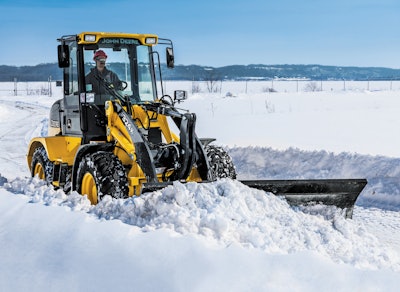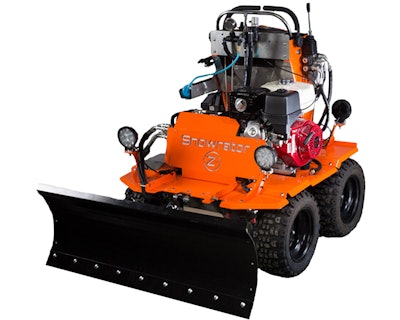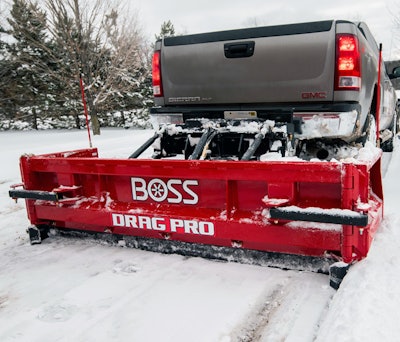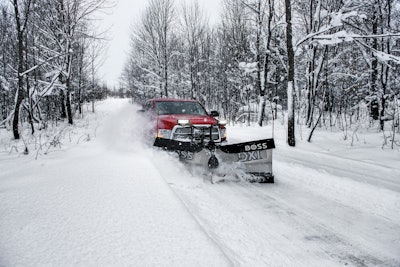 Less-than-capable machinery can result in poor results, so always choose your equipment wisely.
Less-than-capable machinery can result in poor results, so always choose your equipment wisely.Photo: John Deere
Editor’s note: This is part two of a four-part series. The Snow and Ice Removal Guide was created to aid professional landscapers in choosing the right snow and ice management tools for their business. It also includes a comprehensive look at popular snow plow specs. Click here to download the full Snow and Ice Removal Guide.
Want to download the entire Snow and Ice Removal Guide, including comprehensive specs on snow plows, from the editors at TLC?
Selecting the right machine to remove snow and ice will help you both satisfy client expectations and make the most of a shrinking labor pool.
We asked green industry experts to weigh in on their must-have equipment, how to best use these machines, how long this equipment should last and how they use equipment to attract workers.
Several ways to skin a cat
Don’t let your equipment choices be based solely off of what another landscaper uses. Since every jobsite and service area comes with its own set of challenges, tailor your equipment to fit the needs of your customers.
“What’s best-suited for each task often depends upon budget and client needs; there are several ways to skin these cats,” says Doug Knotts, owner of Knott’s Land Care in Amherst, New Hampshire. “My equipment preference is based upon the scope of work.”
Justin Gamester, president and CEO of Piscataqua Landscaping and Tree Service in Eliot, Maine, groups his must-haves into three categories: sidewalk equipment, deicing equipment and containment plows.
 The Snowrator Zx4s are easy to transport to jobsites thanks to their size.
The Snowrator Zx4s are easy to transport to jobsites thanks to their size.Photo: Snowrator
Since sidewalks prove to be the most labor-intensive areas, Gamester says it’s important to find machines that allow your company to be as efficient as possible with as few people as possible.
“Not because I don’t want to hire additional people, but because I can’t find additional people,” he says.
Gamester and his team have found the ride-on Snowrator Zx4 to be a handy tool when removing snow and ice, as it has an optional hopper for spreading material and a blade to push snow. They are also easier to transport in the winter because of their size, he adds. They can either be put on a trailer or a custom caddy can attach to a truck’s trailer hitch.
“We’ve found that these machines were a little more compact getting in areas, eliminating the need for additional shoveling folks,” Gamester says. “Also, the operator in the heated cab can go far longer than the guy that’s out in the elements.”
Understanding which piece of equipment best suits your current clientele list is crucial, as you won’t want to come to a site unprepared for the task at hand.
“Equipment selection is important,” Knotts says. “If a site requires a loader and the contractor chooses a truck, they will find themselves in trouble quickly. Less-capable machinery will provide less-than-stellar results and frequently is a cause for contract termination.”
For Jim Hornung Jr., president of Elbers Landscape Service, Inc. in Buffalo, New York, decking his trucks out with front and rear plows has proved to be the most beneficial move.
“Rear plows are not as common in other areas of the country, but we have used them for 25-30 years and we find that it’s more efficient and more effective,” he says. “So, all of our residential trucks have both a front and rear plow.”
 Some landscapers opt to use both front and rear plows on their trucks.
Some landscapers opt to use both front and rear plows on their trucks.Photo: Boss Snowplow
As a company that primarily covers the city of Buffalo, Hornung says his crews deal with a plethora of sidewalks, streets, narrow driveways, closely built homes and other tight spaces, which means finding reliable and efficient sidewalk equipment is a must.
Gregg Zupancic, product marketing manager with John Deere, recommends the use of a skid steer for snow and ice removal operations, as its versatility will be able to carry over into every season.
“Skid steers are also the ideal machine for landscaping companies that contract snow removal work in the winter – many landscapers own skid steers because of their versatility,” he says. “They work just as well in softer ground conditions, like grass and mud, as they do on snow and create minimal surface damage.”
Experts also agree that when it comes to choosing equipment and attachments, it’s better to be realistic than idealistic.
“I think the big key for people is to figure out what’s the best fit for them,” Hornung says.
Hornung explains there can sometimes be a “macho stigma” that creates a “bigger is better” mentality. This, he says, drives many who are either new to the industry or those who give into the pressure around them to buy the latest, greatest and biggest model of a machine, even when it might never be used in the field.
“I grew up in this business and I learned from the best that you have to face the challenge of staying within yourself and what you do,” he says.
Fighting corrosion
Snow and ice removal equipment will come in contact with deicing and anti-icing agents on a daily basis, and this can result in corrosion occurring on the undercarriage of the machines. This raises the question, when do you know it is time to replace rather than repair these machines?
Even with in-house mechanics at his company, Hornung says they struggle with knowing exactly when replacement is needed over repair.
“I don’t care what you do from a cleaning and sealing standpoint, salt corrodes and adversely affects (the machines),” he says. “Realistically, because of the nature of our winters here, we don’t try to keep trucks much over six or seven years tops.”
Hornung says they will send their trucks out for sand-blasting and powder coating every couple of years as a preventive measure to lengthen the lifespan, but ultimately, it results in a fair amount of undercarriage maintenance.
Gamester says he typically defaults to the manufacturer’s warranty when deciding the lifespan of his sidewalk equipment. Generally speaking, he replaces the sidewalk equipment every two to three years, push boxes every three to five years, salt units and spreaders every five years and trucks every five years. This, he says, also greatly depends on how severe the weather has been that season.
“You have to weigh the cost of repair versus the cost of new,” he says. “A lot of it is knowing that history of the things you own and looking at your repair costs.”
Hornung says that many of the machines his company replaces aren’t always down for the count when they decide to replace them, but with the amount of snow and ice his area receives, “dependability is paramount” to them.
For Hornung, when sending workers out into the unpredictable winter weather, it comes down to having peace of mind that they will be able to come back safely. He adds that you also have to take into consideration the learning curve that might accompany replacing an older piece of equipment with a new one.
Attracting labor
The green industry has taken a significant hit when it comes to finding interested and qualified workers.
While offering higher pay and benefits is a draw to some workers, others might require different incentives to truly get on board with the unpredictability that accompanies winter jobs.
Since Hornung doesn’t see the labor shortage letting up anytime soon, he’s begun investing extensively in equipment that allows his team to be more efficient while also remaining comfortable.
“At some point, the dollars become less of an incentive; I don’t care what we pay them. If you don’t have that in you, you just don’t have it in you,” he says. “But if we can offer them a machine that they think is neat or a machine that offers them a seat, heat, light, room, etc., it becomes a more desirable task.”
Gamester looks at how he can accomplish tasks with fewer people.
 Take care to replace snow removal equipment regularly to ensure worker safety.
Take care to replace snow removal equipment regularly to ensure worker safety.Photo: Boss Snowplow
“You have to look outside the box and look at what’s out there,” he says. “If a job took me four guys, I have to look at how can I do it with two.”
Both Gamester and Hornung say work can sometimes be full throttle one week and scarce the next, which is tough when trying to recruit potential employees looking for steady, consistent work hours.
“When we can reduce the amount of physical labor that we need, that benefits us because it allows us to use the funnel approach,” Hornung says. “You have to have a lot of people at the top to drip out enough people at the bottom to fill the need. If we need about 35 sidewalk guys in a night, we probably need to talk to, on a good night, 45, and on a bad night maybe 65 to get the (number) we need.”
Ultimately, Gamester says it’s important to take stock of the multiple options available to you as a business owner and do what you think will help you the most. He also recommends networking with fellow landscapers to see what methods have been tested and approved.
“Don’t be afraid of new technology, don’t be afraid to ask questions, join up in an association and take advantage of it,” he says. “That’s why we’re here, right? No one’s in it alone.”



![_DSC0823[2]](https://img.totallandscapecare.com/files/base/randallreilly/all/image/2018/09/tlc.DSC08232.png?auto=format%2Ccompress&fit=crop&h=167&q=70&w=250)








